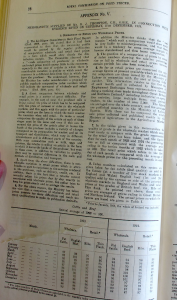Responding to Linlithgow’s insistence on the need for market data to be available on a regular basis, a senior MAF official, Mr RJ Thomson, submitted a more detailed version of the government’s reservations over broadcasting raw price data without a standardised format or structure. Thomson told the commission that MAF was working on a “comparative index” that would somehow make sense of wholesale and retail price movements. It couldn’t be done in the 1920s and I’m not convinced we could do it in 2025. Take the example of a pig producer with slaughter weight bacon pig to sell in 1925. The creature is sold to a curer, who kills the animal and splits it into two sides of bacon. So far we have two mirror image halves of the same animal. One side of bacon goes to a Drury Lane emporium, the other to a Tyneside grocer on the east coast. The cuts that are taken off a London side of bacon, sold in a well-to-do part of London will earn more than the side of bacon shipped to Newcastle, even when the higher shipping costs are factored in. It is so predictable, but illogical, and index numbers won’t explain it.
It is not difficult to spot a flaw in M AF’s argument: the cumulative effect of the changes made at each stage are not counted as part of the process. Is this the only structural flaw?



Leave a Reply